Level 12
The Nuts and Bolts of Mechanics
If you find a path with no obstacles, it probably doesn’t lead anywhere.
—Author unknown
THERE’S NOTHING WORSE than an empty level you just walk through,1 so you need to start throwing things in the player’s way. Good things, bad things, things that make the player cry with pleasure and weep with sadness. You need mechanics. Lucky for you, there are four types of these beauties: mechanics, hazards, props, and puzzles.
The Mechanics of Mechanics
Before you dig in, be aware that “mechanics” is another term that suffers from MDS: multiple definition syndrome. Board game designers say mechanics are the gameplay systems used to play a game. These are things like turns, action points, resource management, bidding, and even rolling the die.
Video game mechanics are objects that create gameplay when the player interacts with them. They can be jumped on, activated with a button press, or pushed around. Combine them with interesting level layouts and enemies. Some of the more common video game mechanics include
- Moving platforms
- Opening/closing doors
- Pushable blocks
- Switches and levers
- Cranks
- Slippery floors
- Conveyor belts
Platforms are a beloved mechanic of action game designers. They come in a wide variety of styles and flavors that can be used to bedevil and delight players. Here’s a suitable-for-framing chart that I’ve devised to help you identify platforms in the wild. Be careful; some of them bite!

You would think that something like a door would be easy to design; after all, everyone has used doors in the real world, right? But doors open their own set of issues. Think about how the player is meant to open a door. Normally? Carefully? Aggressively? Remember, the character’s personality comes into play when you’re thinking about this. Kratos kicks open doors. “Soap” MacTavish uses explosives to blow open doors. Jill Valentine opens doors very slowly and carefully. Does a player have to pick the lock before entering?
Be mindful of which way your door opens. Does it open in? Does it rise up like a portcullis? Does it lower down? Does it swing out? All these opening actions can lead to different gameplay scenarios. You can turn opening a door into gameplay. Some multiplayer games have players work together to crank open a door simultaneously. Mappy (Namco, 1983) used doors to whack and temporally stun enemies. A portcullis in an action game might lower back down after raised, requiring the player to dash under it before it drops down. Even a simple door in a survival horror game can be closed in the face of an enemy to buy the player the time to reload or escape.
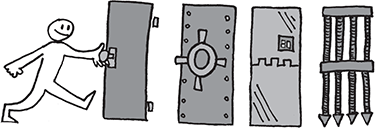
Despite their benefits, doors can bring their own problems. Quickly opening doors can clip into the player or cause the player to get knocked back. Make sure your player doesn’t get caught on doors and doorway geometry. This problem may seem insignificant, but after getting caught up in hundreds of doorways, your player will get mad. That’s the reason so many games make opening doors a canned animation sequence. The early Resident Evil games designed their level loading to correspond with the player opening a door. This design not only masked the loading of the level section but also built tension as the door slowly swung open.
Make sure you know the answers to these questions and then keep the method of entry consistent throughout your entire game.
You can use doors as level gating mechanisms. You might not be ready let the player enter the next room or level. He might have to find the right key, solve the right puzzle, complete the right quest, or earn more XP. A closed door doesn’t need to look like a door. It can be a magic mirror, a mystic portal, a pool of water, a wall of vines, a force field, debris, or a guard blocking the player’s way.
Some doors are just not meant to be opened. Locked doors are perfect for getting players to find another route through a level, but just make sure it’s super clear why they can’t get through. Your locked door can look as if it’s made out of unbreakable metal, it can have a huge lock on it that the player doesn’t have the key for, or it can be blocked with debris that the player can’t move. Whatever the choice, the appearance needs to be obvious so that you avoid frustrating the players. Locked doors are often (some say too often) used to introduce this common gameplay scenario: the quest to find the key.2
Switches and levers are more old standbys in video games. Some designers love using them; others avoid them like the plague. I admit that nothing makes my eyes roll faster than seeing a lever sitting in the middle of a room. It’s something that screams “video game” to me. However, a lever can be a very useful gameplay mechanic. If you do use switches and levers, keep them visually simple. Now I know that one of the great pleasures in designing video games is creating fantastical things, but if you want your players to be able to identify these items in your world it helps to keep things grounded in reality.

Whatever you end up doing with your switches and levers, make sure that
- You include a visual clue. Consider placing a visual effect like a glow or an icon on your switch or lever. Since levers are often shown as slender poles, the player might have a hard time seeing them.
- The player sees the effect of activating the switch or pulling the lever. That means using a camera cut or a voice or sound effect to indicate what has happened.
- The switch or button changes appearance to show that it is in a new state. Have it change color, position, or shape. If you use a one-way switch (one that operates only once), play a nice meaty sound effect to indicate that it’s permanently changed its state. If it’s a resetting switch, play a “timer” sound effect to indicate that that switch is going to revert back to its original state. You can even display a timer graphic so players know how much time they have left.
Cranks are like levers and switches that take time for the player to activate. Some cranks are operated by pressing a button and holding it, whereas others require furious button mashing to open. One common gameplay scenario is to have the player operate a crank to open a door and then have to run back to the door before it closes. Some games turn rotating a crank into a rhythm game where the player has to sync button presses with the animation of the character on-screen. You can even turn a crank into a combat puzzle like the ones in Devil May Cry. If turning a crank takes X seconds to activate, spawn enemies to attack the player as he is turning it. If the enemies hit the player, he’ll be knocked off the crank, which will unwind the crank’s progress. The player will have to alternate between fighting enemies and turning the crank.
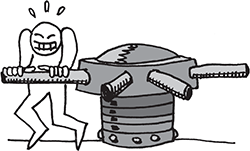
Need a little more help coming up with mechanics? I just happen to have a list in Bonus Level 7.
Holy Death Trap!
A hazard is a mechanic’s nasty little brother who will slip an M-80 into your underpants when you aren’t looking. Hazards look like mechanics, often act like mechanics, but will kill a player just for snoring too loud. Hazards may also resemble enemies, but the key difference is intelligence and/or mobility. All hazards have predictable patterns and limited movement and usually aren’t very smart. They are things like
- Spiky pits
- Smashing blocks
- Blasting flames
- Exploding barrels
- Laser-guided missile launching turrets
When you are designing hazards, the first rule is to make sure that they look dangerous. That means spiky, flamey, frosty, sparky, poison-y. Slap a big death’s head on it if you have to.

When creating your mechanics, take inspiration from the theme of your level. Create things that look as though they belong in the level. For example, in the dungeon level of Maximo: Ghosts to Glory, we had
- Grabbing prisoner hands that pop out from grates
- A suit of armor wielding a chopping axe
- Spinning, spiked iron maidens
- A toxic sewer filled with floating coffin platforms
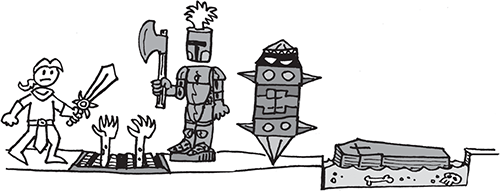
Get inspiration from dangerous-looking things in the real world: from spiny cacti to razor wire. Use shape, color, sound effects, and particle effects—anything to make it clear to players that they WILL get hurt if they touch or collide with this hazard. Don’t make the player have to play a guessing game to what your intention is. Use visual shortcuts and stereotypes—they can be used as a great shorthand tip to the player. To demonstrate this point, here is a great example of what I DON’T mean.
I was designing a hazard and took the design to the artist who was going to be modeling it. I suggested that the hazard be colored red, as many cultures associate the color red with danger. The artist said, “That’s too predictable. I think it should have yellow and black stripes.” I was intrigued (I was thinking of the yellow and black hazard edging found on loading docks), so I asked her why. She replied, “Because bees have black and yellow stripes, and everyone knows that bees are dangerous.”

Epilogue no. 1: The hazard ended up red.
That story reminds of another story. A designer and I were reviewing level designs. A particular level featured a ship that would sail away as the player started the level. The player had to run to catch up with the ship; otherwise, he would literally miss the boat. I told the designer that I thought that the player would stop and look around to get his bearings when he started a level. If the player took the time to do that, he would literally miss the boat. What would happen to the player if that happened? The designer said, “Oh, we can just drop a big rock on the player’s head, so he’ll die and have to start the level over again.”

Epilogue no. 2: We didn’t make that level. Since then, I made this very important thing my motto:
NO DROPPING ROCKS ON THE PLAYER’S HEAD3
Instant death hazards just suck. They are cheap and mean-spirited. If the player dies because of a hazard, it should be because he didn’t pay attention or get the timing right. Make the player realize it was his fault he died, not because the designer decided he needed to die. Death is never a good way to educate the player. It just makes the player frustrated and sad.

What I Learned from Making Kids Cry
Whenever I meet gamers who played Maximo: Ghosts to Glory they will often tell me that they never finished the game because it was just too hard. And you know what? It is. It demanded players make pixel-perfect jumps and be combat ready the minute they landed in front of an enemy. It has a needlessly cruel save system. It’s been called one of the most difficult PS2 games of all time4. It’s a difficult game. And after making that game and reading the reviews, I learned my most important lesson as a game designer: The difference between difficulty and challenge.
Difficulty = Promotes pain and loss
Challenge = Promotes skill and improvement
A difficult game does whatever it can to punish the player. A challenging game confronts the player with obstacles that can be overcome with skill and knowledge. I believe a challenging game is much more rewarding than a difficult one.
Some gamers absolutely love difficult games. The list of ridiculously difficult games could fill this entire chapter: Demon’s Souls series, the Ninja Gaiden series, Contra, Ikaruga, Shinobi, Devil May Cry 3, the Ghosts ‘n Goblins series, Super Meat Boy, Battletoads. I admit, it is quite an accomplishment to finish a difficult game, but those who do are in the minority. If you want players to play your game to completion, your game needs to be challenging, not difficult.
When I first started designing video games, I would refer to the balance between challenge and difficulty as the “fun curve.” There is a point in the game at which things have ceased to be challenging and drop straight into difficult and frustrating. The goal was to never “go over the fun curve.” Years later, I learned there was an actual psychological theory about the fun curve called “flow.” I get to flow in a moment.
My key to keep players from “going over the fun curve” is to create ramping gameplay. A designer must build one gameplay system upon the last, teaching players a new move and how to master it against mechanics and enemies. These gameplay elements are combined and gently intensify as the game progresses. But I’m getting ahead of myself. If we are going to talk about the timepiece, we are going to have to examine the clockworks first.
Time to Die
When I think of clocks, I think of time. When I think of time, I think of timing puzzles. Timing puzzles are mechanics that move. They are perfect for creating tense moments when a player has to wait for the right time to dash through whirling blades or smashing pylons.5 They cause anticipation for the player as he waits for the right moment to jump to a moving platform. A timing puzzle should have the following:
- The hazard must have a discernible movement pattern. The pattern can be back and forth, up and down, zigzag, circular, or figure eight: just as long as players can track the hazard’s movement and determine when to act.
- The hazard must have predictable timing. Random timing is unfair to players, who need to understand the pattern to be successful.
- The window of opportunity must be tight, but not impossible. Allow leeway for players at the start and close of the window’s opening.
- Use “tells” in the world to give players clues to where it is safe to stand and where they will be hurt or killed. Bloodstains, grooves in the floor, lighting and shadows, sound effects, particle effects, geometry, decorative elements—players notice these things and will learn to use them as markers for success.
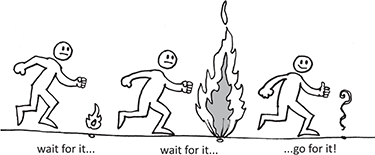
Props are mechanics that have eaten a big Thanksgiving dinner; they don’t move unless someone asks them to get off the couch and do the dishes. Designers and artists can place these items into the level to make it feel more like a real place. Sometimes props act as barricades or obstacles for the player to avoid, jump over, or take cover behind:
- Desks and chairs
- Parked cars
- Barricades
- Statues and gravestones
- Refrigerators
- Fences and walls
- Coffins and alters
- Fire hydrants
- Mailboxes
- Filing cabinets and tool boxes
- Computer consoles
- Tables, wardrobes, and dressers
- Crates
- Potted plants and water coolers
Thinking up props can be an entertaining exercise in free association and brainstorming. Start with the predictable items that you would find in your level and go from there. Here’s an exercise: come up with as many items and props as you can for the following level themes:
- Easy—The street of a Wild West town
- Medium—A supervillain’s lair
- Hard—Chinese clothing factory
Pro tip: If you find your brainstorming ideas getting silly or obnoxious, you know you’ve reached a good place to stop. Let your ideas settle overnight or for a day or two before starting again. Or take a research break and look for more inspiration in books, games, movies, or the interwebs.
Don’t be satisfied with merely thinking up items to decorate your world; allow your players to interact with them. Start with natural reactions. If you shoot a water cooler, it should explode in a watery splash. Let players knock over light items or shove around heavy ones. Let players closely examine interesting statues, objects on bookshelves, or paintings.
You can shoot or smash props to access new areas or yield treasure. In the LEGO games (like LEGO Star Wars and LEGO Batman), you can pretty much destroy anything—all yielding studs, the game’s version of money. Nothing is more satisfying than busting up junk to get tons of treasure, but try not to overdo it because it can turn your carefully designed level into an empty room full of rubble.
Crates are breakable items that yield goodies and double as platforms, but they’re also overused clichés that have become a joke within the gaming industry—visually boring and, frankly, a lazy fallback for designers and artists who don’t want to burn the brainpower to think up more interesting breakable objects.
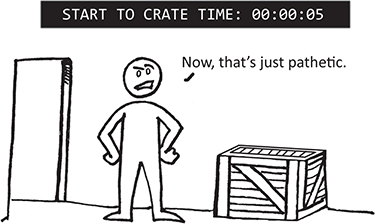
Gaming website Old Man Murray6 created a review system called start to crate that gauges the time it takes a player to encounter a crate in a game. While the article is meant to be satire, I find it to be a good gauge to determine just how creative your game is. Rather than reinvent the wheel … er, crate, you can use this list of 50 breakable objects other than a crate to populate your game:
Barrel, treasure chest, vase, urn, trash can, mailbox, newspaper stand, baby carriage, metal drum, cargo container, cardboard box, cage, lantern, lamp post, filing cabinet, fish tank, toy box, keg, hay bale, pile of skulls, dog house, bird house, Tiki idol, statue, fortune-telling machine, church donation box, suggestion box, ATM, hollow tree stump, attaché case, safe, suitcase, TV monitor, fuel tank, refrigerator, oven, breadbox, bureau, wardrobe, parked car, coffin, arcade machine, soda machine, fire hydrant, vending machine, oxygen canister, filled shopping cart, one-armed bandit, copy machine, and toilet.
There. You never have to have a crate in your game again. You’re welcome.
There is one more type of mechanic, which is the rarest one of all. It’s the mechanic that’s “just for fun.” This can be the player piano that plinks out a tune as you approach it or the toilet that flushes if you interact with it. Don’t be afraid to include these just-for-fun props in your own game.
The Music of Mechanics
In the great chili pot that is video game design, hazards are the beans. Just like beans, they act as filler when you don’t have enough meat to go around and … they help the designer make “music.”7 The goal of good level design is to help players achieve what psychologist Mihály Csíkszentmihályi8 calls flow. (I told you we’d get back to it.)
Csíkszentmihályi’s theory proposes that there is a point between boredom and difficulty. A place where players become so engrossed that they become energized, focused, and unaware of time. But in order to create flow, you need to know how to orchestrate these elements together.

Reaching the state of flow feels like making music; it’s the rhythm of a great level. A natural rhythm of the player’s movement and actions—or flow—starts to emerge as he traverses the level.9
To me, game element placement is orchestrated like the instruments in Sergei Prokofiev’s Peter and the Wolf. In this famous musical piece, each character (Peter, a duck, a cat, a bird, and the wolf) is represented by a different musical instrument. The piece starts out with Peter (represented by strings) walking through the forest. This musical theme gives the impression of movement, just as the player is learning how to do the basics in a game: walking, driving, or manipulating the game character.

Then Peter is joined by the bird, which adds a higher register flute to the music. The two themes intertwine, adding excitement to the music—just as treasure and collectables keep the player excited and motivated to continue playing. The duck (represented by an oboe) joins in, and the music speeds up and gets more complex, similar to the addition of complex player actions and level mechanics to your design. When the lower register cat (a clarinet) comes in, the music picks up as the cat chases the bird, adding a little conflict to the piece—much like hazards in a level.
After all the characters are together, the wolf’s dangerous-sounding theme comes in; this echoes the arrival of enemy characters in a game. The music in Peter and the Wolf intensifies as the wolf eats the duck, is attacked by the bird, and threatens and battles the heroes until they are rescued by the crashing arrival of hunters. (Represented by drums.)
Let’s take a look at how to introduce and orchestrate gameplay elements the same way that Peter and the Wolf adds instruments.
- Start your player character moving through the world with simple movement challenges: walking, jumping, and collecting goodies.
- Start with one mechanic. Repeat it a couple of times so the player understands how it works.
- Add a second mechanic, and let the player learn that one too. Then combine the first one with the second.
- Make things exciting with a hazard. Let the player get used to doing the things he would normally do in the game (traversal, collection, interaction with mechanics) but now with the hazard being part of the equation.
- Now come the enemies! Give the player a chance to learn how to fight them.
- Combine the enemies with the hazards for more excitement.
- Finally, just as the player is getting used to all these game elements, toss one of them on its head just to keep the player on his toes!

If you create enemies and hazards to complement each other,10 they’ll end up being versatile tools when populating your level. Think about what order you want players to do the activities and set up the scenario for the players to figure out. Here are a few examples of how to combine enemies and hazards to make life more difficult for your players.
- The player has to jump over the hazardous pit with an enemy waiting on the other side. Place the enemy far enough away so he doesn’t engage the player until he safely lands after the jump. To make this scenario more intense, make sure the pit has a timing element: the pit opens and closes, a pendulum swings back and forth, fire shoots up, a block slides down, and so on.

- Here’s an enemy that throws or shoots a projectile through the path of a moving hazard. Design the timing so that it passes through when the opening appears. The solution is for the player to dispatch the enemy (with his own projectile) before running through the moving hazard. Or the player can use the moving obstacle as cover to get in closer to the enemy.

- The whirling saw blade in this chamber will cut the player in half if he collides with it, which makes fighting these multiple enemies a challenge; the player has to dance between combat and avoiding the hazard. However, the blade should also kill the enemies, which makes the player feel clever when he lures them to their death by saw blade. Give the player plenty of opportunities to turn the death traps against their makers. It’s all about the villains getting their comeuppance!

Fire pit, moving obstacle, and whirling blade—there are many more combinations you can do with just these three mechanics. As these examples show, you really need only a few mechanics and enemy types to make a rich play experience. A well-designed game uses a handful of mechanics. The key is how you combine them. Play any game by developers Treasure (Gunstar Heroes, Dynamite Heady, Ikaruga) or Naughty Dog (Crash Bandicoot, Uncharted) to see some great examples. Or you can just read the next section.
Chip Off the Old Block
I believe that the best mechanics are also the ones that are the most flexible. By changing a mechanic’s context and use you can create an entirely new challenge. Let’s look at a mechanic that can be found in many action and adventure games—the pushable block. While this mechanic is often maligned for being slow, unrealistic, or boring, the pushable block mechanic continues to be used by designers because it’s flexible. Let’s follow our hero through the dungeon to see different ways we can use a pushable block for gameplay.
Welcome to the dungeon! Unfortunately, our hero’s path is blocked by a large stone block. But if we push it aside, we can enter.
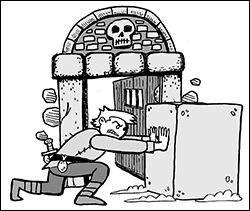
Now our hero has to get up to that ledge. No problem. We just push a block to create a platform that he can jump up onto.
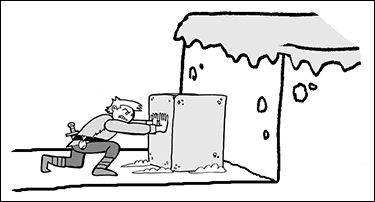
Ah, the old switch gate. If our hero stands on the switch, the gate will open, but when he steps off, the gate closes. What to do? I know! Let’s drag that block on top of the switch, its weight will keep the gate open!

What’s this? A vent shooting a jet of fire? Let’s have our hero push the block over it. Now the fire is blocked and our hero can progress without getting roasted.
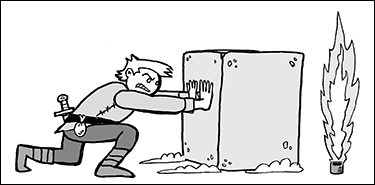
Curious. These pushable blocks have letters on them. It must be a puzzle! Nobody said we would have to think in this game! By pushing these blocks into the proper sequence, our hero can E-X-I-T the room!

Who put a pit of acid in our way? That’s a dirty trick! Fortunately, our hero can push a block into the pit and use it as a stepping stone.

This monster is looking for us! But the monster can’t see our hero when he’s standing behind the block. Maybe if he alternates between pushing and hiding, he can escape being captured!
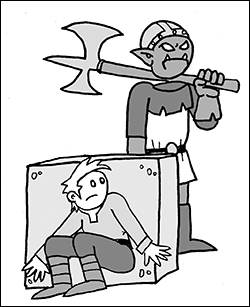
That skeleton archer is making life difficult for our hero. But if he pushes the block and uses it for cover, he can survive to reach the far end of the room.
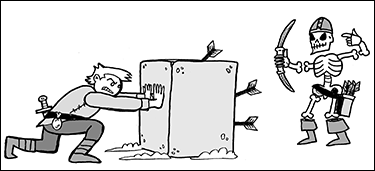
Oh no! How is our hero going to get past that Cyclops sentry? Pushing that block off the ledge onto to his head ought to do the trick!
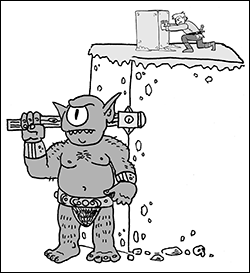
That’s a lot of flexibility for just one pushable block! And we haven’t even explored pulling the block! Be mindful that it is possible for players to get bored with mechanics if they are repeated too often, so think about the context in which they are used. A good mechanic is like a baseball pitcher. You need to rotate them in and out of your game to keep them fresh and effective.
A Nice Little Calm Spot
Now that you’ve gotten past the hazards with your life, it’s time to talk about a friendlier mechanic: checkpoints. Checkpoints are predesignated locations within the level where players can save their progress; take a break; or reassess their choices of equipment, route, and so on. They can be invisible to the players or visible. You will want to determine which method is better for your own game.
On one hand, visible checkpoints offer players a target in the level, provide a sense of security when they are activated, and can be an opportunity for an exciting or fun animation. The players feel a sense of accomplishment every time they reach and activate one.

On the other hand, visible checkpoints can look “gamey” and sometimes require explanation on how they can be activated.
Invisible checkpoints don’t break the players’ immersion while playing the game. However, because they are invisible, players may not be sure when they are activating a checkpoint or where they will respawn upon death. This can be frustrating for players as they wonder how far back in the level they will end up.
No matter which style checkpoint you use, here are a few rules of thumb to remember:
- Always face the checkpoint in the direction you want players to travel in. Otherwise, they’ll get turned around or have to reorient themselves or the camera upon respawn.
- Never place a checkpoint next to a hazard or in the detection zone of an enemy. It’s totally cheap to take damage when you (re)appear in a level.
- Players should respawn on the ground, not in mid-air. Don’t make the player wait for the character to land from a drop. Also, avoid long respawn animations for the same reason.
- Place the checkpoint on flat, even ground to avoid any collision problems upon respawn.
- Make sure your game’s saved data is retained whenever a checkpoint is activated. Don’t make players go into another menu just to save the game.
Riddle Me This
Puzzle mechanics can be tricky; not just because they can be difficult to design or because they often require unique assets to create. It’s just that puzzles are tricky to classify. Here’s one definition I’ve found:
A puzzle is fun and has a right answer.
—Scott Kim
While Mr. Kim has designed waaaay more puzzles than I ever will,11 this definition doesn’t feel quite right to me. What bothers me is the use of the word “fun.” Fun is completely subjective, like the words “funny” and “sexy.” What I think is fun may not be fun for you. And frankly, I don’t find many puzzles in video games to be fun. For me, there’s nothing worse than a puzzle whose solution I just can’t fathom. At least with a difficult boss monster, you can brute force your way through to victory. You just can’t do that with a puzzle. So, with apologies to Mr. Kim, I have created my own definition:
A puzzle is a challenge that has a right answer.
—Scott Rogers
The difference is the word “challenge.” That’s a puzzle’s job (and the entire game’s job for that matter!): to challenge players. And the challenge the puzzle offers players is “solve me.”
Players first need to know what reward is offered for solving the puzzle. It can be to open a door, create a picture, or translate a message. Just make sure players know what they need to do first. I always think this very important thing applies:
SHOW ’EM THE DOOR AND THEN SEND ’EM AFTER THE KEY12
When creating the puzzle, keep the puzzle’s pieces simple and modular. You need only a few pieces to create many combinations. Work with as few pieces as possible to prevent players from getting confused. Make it simple for players to manipulate the puzzle pieces when rotating or flipping them. Make sure that when a puzzle piece is adjusted or changed, players can see that it’s been adjusted and a clear way to return it to its original position. Many times it’s easy to lose track of any progress. Keep the pieces uniform unless irregularity is part of the puzzle. Uniformity and consistency will keep it easy for players to understand how the elements fit together. Let them concentrate on the puzzle, not the manipulation of the pieces. When players interact with a puzzle piece, a simple button press should show a result. It may not automatically lead to the solution, but they should get the idea that doing the action in a different way will eventually get them there.

When I’m confronted with a puzzle in a game, I “check the puzzle” against every ability I have, every item I’m carrying, and every object in the room. This is the biggest pitfall of puzzle games; they end up being boring permutation fests. Think about what the piece is and its relationship to the other pieces as well as to the entire puzzle. If the relationship of the puzzle pieces isn’t clear, it’s easy to get stumped. And another thing, don’t use cultural references (which could be confusing to a foreign audience) or make the player have to use the piece in a bizarre or absurd way to solve the puzzle.
For example, Resident Evil 2 had a puzzle in which the player needed to open a door in a police station. The puzzle required placing chess pieces into a control panel. Whaaaat? First of all, since when do you find chess pieces in a police station, let alone ones that operate a control panel? Now if it had been … I don’t know … the ID cards of dead police officers found throughout the station, the puzzle would have made more sense. What I’m getting at is: tie the puzzle into the game’s story or setting, and it won’t seem so senseless or random to the players.
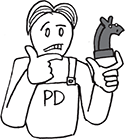
Players should have all the tools nearby that they need to solve the puzzle. I like to place puzzle pieces no further than two rooms away from the puzzle’s solution. It’s not fair to make players run all over the level, let alone the game world, wondering what works to solve the puzzle and what doesn’t.
The layout of the puzzle is as much a clue as the pieces. For example, if you present a chess board-style layout, players can visualize movement and patterns using the board as a guide before they tackle the problem. If the puzzle pieces are moved in a certain way, players should be able to visualize the consequences of moving the pieces. Just like with timing puzzles, movement and layout will help players see pattern that will help them reach their goal.
Puzzles in video games are essentially gating mechanisms. If you have lots of puzzles, make sure there are multiple paths of progression. Eventually, players will have to come back to the puzzle that stumped them to solve it. Give the players time to figure out the solution of a stumper while giving them another puzzle to solve in the meantime.
Tell players whether they are close to finding the solution … or not. Remember that kid’s game where you are searching for a hidden item and another player says “you’re hot” or “you’re cold” depending on how close you are? Essentially, that’s what the game designer needs to do for the players. Make your hints relevant to the puzzle. Ask yourself, “What would I want to know at this point?” Remind players what their goal is. Use camera cuts to show cause and effects that happen during the puzzle. Use voice and sound effects to give positive reinforcement. There are really only four ways to solve a puzzle: reason, knowledge, skill, or plain ol’ dumb luck. The best puzzles allow players to use all four of these ways in some capacity to solve a puzzle. Granted, you don’t want players to stumble onto the solution, but if that’s what it takes, then stumped players should at least be able to do that.
You need to give players the “Ah-ha!” moment. It’s the moment when they realize how the puzzle fits together and what the solution is. They may still need to complete the puzzle, but that part should happen quickly; by that point, it’s just a matter of getting the grunt work done.

However, if players don’t get that “Ah-ha!” moment and fail to solve the puzzle, don’t make it a big deal. Find a way for the puzzle to be solved regardless of the players. Give them hints or even the answer if you have to. Of course, getting the solution without solving the puzzle should cost players something—a bonus or cash, as with the diminishing rewards in the Professor Layton games. If players need a hint, just charge them a fine and then let them skip ahead. Don’t make them keep guessing wrong answers and then punish them for their mistake. And don’t make the punishment something so severe as losing a life. Progression is a right, not a reward.
While I have found that players are generally smarter than you might think when it comes to solving puzzles, you should not give your puzzles cryptic or nonsensical solutions. The most infamous adventure game puzzle was in Gabriel Knight 3: Blood of the Sacred, Blood of the Damned. The player had to disguise himself as a non-player character to gain entry into a location. To create his disguise, the player had to stick tape over a hole in a fence that a black cat passed through. The cat’s back would rub against the tape and hair would stick to the tape, which the player would then use to create a mustache for his disguise. However, the character the player was disguising himself as DIDN’T EVEN HAVE A MUSTACHE! My very important motto for creating puzzles has since become
NO CAT MUSTACHES

In other words, don’t be so darn clever that players never figure out the puzzle. If you have created a Rube Goldberg-style13 solution to your puzzle, you’ve overthought things and you need to simplify your puzzle. The conflict for players shouldn’t be “game designer versus player” but “player versus puzzle.” So check your ego at the door and do what’s right for the players and the game.
Puzzle Me That
Of course, up to now, I’ve been talking about the kinds of puzzles that you find in story-based games, but there are so many more types of puzzles. The puzzle genre is the broadest in video games, and these games vary widely in content and gameplay. Let’s look at some of the different types of puzzle games:
- Logic puzzles are often found in adventure games like the classic games from LucasArts and Sierra. They rely on players finding inventory items and then combining them to solve the puzzle. Make sure the relationship between the items and the solution makes sense (no cat mustaches!) and make it easy for players to combine and test items as they seek the solution.
- In match three puzzles like the Bejeweled series or Dungeon Raid series, players match three or more icons (or jewels or pirate skulls or quilted teddy bears) for points. Match three expert Jasper Juul splits these “breaker” games into four design foundations: manipulation, match criteria, obligatory matches, and time. Each of these factors can greatly impact how the game is played and affect the game’s difficulty. Match three games offer short play sessions, which has made them popular on mobile devices. This extremely flexible genre is a good match (ugh) with other game genres such as RPGs, word games, and even horror.
- Math puzzles challenge players with arithmetic, subtraction, multiplication, division, spatial geometry, and number ordering. If you are going to have math puzzles in your game, it doesn’t hurt to disguise them. You can put learning into a game, but the minute players catch on that they’re learning, they won’t want to play anymore. Give them something else (that would be gameplay!) to concentrate on as they learn.
- Rigid body physics puzzles like Angry Birds or No, Human simulate real-world interactions between objects and environments to create challenges for players. Weight, density, momentum, force, velocity, and kinetic energy become design tools to create challenges. They can be based on balancing stacks of items, engineering stable structures, launching aerodynamic craft, and just smashing up stuff!
- Liquid physics puzzles like Where’s My Water or Engimo simulate fluid dynamics from streams of water to giant waves. Don’t forget water has momentum, viscosity, force, drag, and buoyancy that affect your sea-worthy game elements.
- When creating trivia and knowledge puzzles, don’t assume everyone knows what you do. Keep your questions short and clear. Do your research and determine what kinds of questions your audience would have fun answering. Players should feel smart for knowing the answers. Make sure you have a wide range of difficulty from simple to obscure, but mostly simple. Write lots of questions. Knowledge games cease to be fun the minute you have answered all the questions. There are many different ways players can answer a question. Which one is right for your game?
- Multiple choice—Give players a range of choices—at least three. Create “close answers” that are similar to the answer but could be easily confused with the real answer. Change things up occasionally by asking “Which of these is not true?” style questions.
- Find the object/image—Players must hunt for the answer among a variety of images or objects. Don’t make the hunt be pixel perfect. Instead, allow a little space around the item so players can eventually spot and select the answer. Play with image orientation, color, and size to keep your players hunting.
- Fill in the answer—This type of response requires keyboard or writing tablet input. Make sure your word parser is flexible enough to allow for misspellings, synonyms, colloquialisms, and regional terms. Scribblenauts has 22,802 words in its vocabulary! If your puzzle’s vocabulary is smaller than that, consider letting players learn what words are available so they don’t waste time guessing ones that aren’t available.
- Traditional puzzle games like Sudoku and crossword puzzles offer simple challenges. Simplicity is the key here. Make sure your puzzle has only one solution. Allow players to make notes or try out different solutions before committing to the final answer. Add prompts and helpful hints to players. It’s better to help players along than let them get frustrated and quit playing the game. Create multiple levels of challenge for all levels of players.
- Visual puzzles, especially hidden object games like the Nick Chase series or Criminal Case, rely on the players’ observation skills. As in match three games, you’ll find visual puzzle games come in a variety of genres, including mystery, horror, and romance. This may be thanks to the popularity of hidden object games with female gamers. Here are a few pointers for designing hidden object games:
- People search for visual patterns like shapes, sizes, and colors. By adjusting these, you can hide your objects easily.
- Fool around with player expectations by using non-stereotypical visuals for your items.
- Hide objects in plain sight. The most overlooked image is the one right in front of players.
- Direction and rotation make a big difference in how an object is recognized. Turn an object 45 or 180 degrees to throw off your players.
- Word puzzles like Scrabble, Words with Friends, and Letz focus on spelling. When creating word puzzles, be careful about using slang and colloquialisms. Word games should be visually uncomplicated. Design your interface with clarity in mind. Be careful not to use an illegible font for your letters. Really think about how you can present your word game in a more interesting way like Typing of the Dead did.
Whew! I’ve just barely scratched the surface on puzzle games. It doesn’t matter which puzzle genre you design. Just make sure you keep the gameplay fair, the objectives simple, and the logic sound.
Minigames and Microgames
A minigame is a simple game created to provide variety, represent activities, and add value to a product. Many minigames are based on or are variations of classic arcade and classic home console games.
A microgame is a minigame that takes only seconds to play. Half of the challenge of microgames is learning how to play them within the short time allotted. The WarioWare titles are compilations of microgames.
Minigames offer many advantages to game developers. They are quick to create and test, they are easy to play, and they can be used as metaphors for complex player activities. I truly believe ANY activity can be represented by a minigame. Observe:
- Lockpicking—The Elder Scrolls IV: Oblivion (2K, 2006)
- Hacking electronics—Batman: Arkham series (WBI, 2009)
- Portrait painting—SpongeBob Atlantis SquarePantis (THQ, 2008)
- Tagging walls—The Warriors (Rockstar, 2005)
- Cooking dinner—Cooking Mama (Majesco, 2006)
- Serving dinner—Diner Dash (Playfirst, 2003)
- Picking a nose—WarioWare (Nintendo, 2004)
Any activity.
When designing a minigame, make sure to
- Keep the controls simple. Minigames, by their nature, imply easy-to-learn gameplay.
- Keep the gameplay sessions short—no longer than 2 to 3 minutes. Some microgames can last only a few seconds.
- Ramp the difficulty gently. Minigames are meant to provide variety, not torture players.
- Add something new with each level. Even a different piece of background art, sound effect, or song keeps the game from getting stale or repetitive.
- Design the minigame’s controls using one button, touch control, or a very simple control scheme.
- Allow for player customization if possible. The web-based minigame Upgrade Complete (Kongregate, 2009) allows players to upgrade EVERYTHING, including the player’s ship, the background graphics, and even the copyright screen!
- Make the victory condition clear to players. How does your minigame end? Does it have an end? Some games can be played “forever”—or at least until the kill screen appears.
Minigames don’t even need to be segregated from the core game. The platformer/puzzle game Henry Hatsworth in the Puzzling Adventure (EA Games, 2009) and the RPG/puzzle game Puzzle Quest (D3, 2007) combine two styles of gameplay: platforming and puzzle. If you do this in your own game, just make sure you allow time for players to make a “brain shift” between the two gaming styles. Give them a second to reorient themselves with a “ready” screen or pause in the action.
And finally, when you’ve run out of all other creative ideas of minigames and puzzles, you can always resort to Whack-A-Mole.

Seriously, please don’t. I consider Whack-A-Mole the last stop on the designer’s creativity train. And here’s why:
- It relies solely on the player’s reaction time, which requires no thought or decision making from the player.
- It’s random, which doesn’t let the player utilize strategy.
- It’s very repetitive. There’s no variety to the gameplay other than possibly the speed of the popping moles.
- It requires almost no input from the player other than a single motion, button press, or click.
- It is an “endless game”—there is no end unless the designer dictates it. Usually, the player stops because he’s tired of playing it.
I know you can design something more engaging than that! Let’s move on to something more exciting: power-ups!